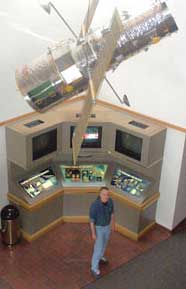Meanwhile, In Linuxville…
[Geek Alert…]
I run CentOS 5.2 here on Mowgli, the main workstation here at Casa del Garrett. Those of you who’ve been with me for a while, may remember my "Clawing My Way To Linuxville" series of posts. So far, I’ve been enormously happy with CentOS, which is basically Redhat Enterprise but without the proprietary Redhat parts. Linux nowadays seems to be a perfectly acceptable replacement for Windows in a lot of applications. So I was unimpressed, to say the least, to read all this over on Slashdot a moment ago…
Linux: Linus Switches From KDE to Gnome
An anonymous reader writes "In a recent Computerworld interview, Linus revealed that he’s switched to Gnome — this despite launching a heavily critical broadside against Gnome just a few years ago. His reason? He thinks KDE 4 is a ‘disaster.’ Although it’s improved recently, he’ll find many who agree with this prognosis, and KDE 4 can be painful to use." There’s quite a bit of interesting stuff in this interview, besides, regarding the current state of Linux development.
KDE and Gnome the two popular graphical user interfaces for Linux. Think of them as the Windows part of Microsoft Windows. Reading the Slashdot user comments about KDE debacle put me in mind of the disaster that was Windows’ Vista, but on a smaller scale. This only affects one windowing system…the other is apparently still stable and usable. But many Linux users find Gnome to be much too simplistic. I use KDE myself, largely because of it’s flexibility and it’s feature depth. I particularly like the copy buffer icon on the taskbar. I use that a lot because the Linux copy buffer is not nearly as smoothly integrated with everything else as the Windows and Mac copy buffers are. That’s the difference between Open Source and proprietary. In Open Source land you have a lot of different people all doing their own thing while still trying to get along with each other somehow.
I’ve been unaffected by this KDE issue. CentOS isn’t bleeding edge Linux. Sometimes that means there are features missing from it that the more trendy Linux distributions have. But it is very stable and usable and that’s why I’ve kept with it. That they have waited for KDE 4 to get itself sorted out before pushing it out to their user base really impresses me a lot now. I had no idea all this was going on over in KDE-land and that’s because the CentOS software updates never forced it on me. If my Linux desktop had broken the way some of these Slashdot commenters are complaining about I’d have been furious.
What you need to understand about Linux, for those of you still a bit mystified by it, is that Linux is just a kernel. The kernel is the most basic part of a computer operating system…it’s the low level functionality that manages memory, input-output, loads and runs applications, and so on. The part you and I interact with is called the Shell. A shell can be a simple text based command-line or it can be a dazzling graphical interface with Windows and sound effects and all sorts of eye candy. But basically the shell is the user interface…the part that allows you to tell the kernel what you want it to do, and get messages back from the kernel about what it’s doing. There are also other "layers" that control things like the network connections and video display. Think of all this as layers of an onion, with the user interface, the part you and I see, at the top and the kernel at the bottom, right next to the actual hardware which is at the very center. That’s your computer the way the software running on it sees it.
Linux is just the kernel part. Everything else is the layer stuff added onto it. That layer stuff is usually packaged into "distributions" so you and I don’t have to spend hours if not days building everything ourselves from the kernel out. Popular distributions are Redhat, SuSE, Madriva, Ubuntu, Debian. There are tons of others, including such as "Scientific Linux" which some folks at work use, and Kbuntu, which is Ubuntu disaffected. Each Linux distribution, or "distro", builds up and tweaks the layers in its own way. Some are more targeted toward server usage. Some, like Ubuntu, target the desktop user. The thing to keep in mind is that they’re all different takes on how to build a complete operating system from the basic Linux kernel.
As I said, I run the CentOS distro nowadays. It’s not nearly as trendy as Ubuntu, and there have been times I’ve been disappointed that it lags well behind other Linux distributions in terms of features and supported applications (I still can’t get the Amazon mp3 downloader to work on it) But CentOS is a very stable platform to be running on, which I really appreciate. I can do most everything I need to do on it, and what I can’t do on CentOS I can on one of my household Macs. So I don’t need Windows anymore. I have an XP license for Mowgli that I haven’t booted up in almost a year. Its security patches are so out of date now that I’m almost afraid to.
CentOS, as I said, is Redhat Enterprise without the Redhat proprietary parts. It’s all open source and "free" software. The other thing you need to understand about Linux, is the Open Source part. Open Source is free as in "free beer", but more critically to those of us who work with computers for a living, Open Source is free as in freedom. That Windows XP license I have is a good example of what I mean.
I had to rebuild Mowgli some time ago, when its motherboard failed. XP uses an online license branding scheme that only unlocks Windows for use if you have a valid license key. When you install it on a computer, you have to give it your key and it phones back to Redmond to verify that the key is genuine. Then it grabs the serial number off your CPU, and the mac number off your network card and a few other unique IDs from various hardware components and then it computes a "brand" for your individual machine which it then encrypts and records somewhere. Whenever you start Windows up it checks the brand against the hardware to make sure it’s still running on the same machine you installed it on.
Suppose you have a hardware failure and you have to replace something with one of those unique IDs the brand was generated against? XP will know when you boot it up after replacing hardware, that something changed. So long as your license key was valid, it will simply recompute the brand. But only up to two times. After that, you must call Microsoft and ask for permission to reinstall XP. You have to call Microsoft in other words, and convince the droid you’re talking to that you’re not pirating their software by copying it onto more machines then you bought a license for.
This is simply not an issue with Open Source software. Your machine breaks…just fix it and re-install Linux. Replace a motherboard? No problem. Need more power? No problem. Go ahead and upgrade anything on your machine. Replace that memory. Get a new video card. Get a faster network card. Upgrade the whole motherboard. It doesn’t matter. Need a second machine? Fine. Go ahead and install your copy of Linux on that one too. Go ahead and give a copy to all your friends for that matter. It’s no problem.
As a software engineer whose career has shifted a tad away from coding applications to designing and integrating systems, I’ve seen over and over how restrictive licensing demands from commercial vendors stifle productivity and innovation. And it’s making people switch to Open Source more and more. At the Open Source Developer’s Conference in Portland last year, a group of folks from one NASA project focused on satellite image analyis, told us how they chose several Open Source development platforms to do their experiments on, specifically because they knew they’d eventually have to scale them up to more powerful computers and they didn’t want to have to deal with re-licensing and re-branding their software every time they upgraded their hardware. Now whenever they need to upgrade the hardware they just pick their software up and plop it down on the new hardware and that’s that. Free software is about Freedom, not free as in getting something for nothing.
Some commercial Linux distros are trying to take a more Microsoft approach to their business model, and have instituted a limited software branding scheme. They do that mostly to sell their maintenance services to the business community. Redhat Enterprise now brands itself in a way similar to Windows XP. But you don’t need to bother with Redhat unless you are a business and you would rather use their technical support then your own in-house IT staff to maintain your workstations. Linux and other Open Source software is typically distributed under a license that allows anyone to use the software and freely incorporate it into their own proprietary software products, so long as the Open Source part remains open and freely re-distributable.
That is how CentOS can distribute a Linux version that is almost Identical to Redhat Enterprise. It is basically all the open source parts of Redhat enterprise, without any of the the proprietary Redhat stuff in it. So it’s missing, basically, the Redhat installer, the Redhat software updater, and a few other proprietary Redhat componants. Open Source replacements exist for all those proprietary componants, so this is no problem. You are completely on your own in terms of support…but that’s the other side of the freedom coin. If you need support, then you can always buy a commercial distro. End user licenses for those are usually a lot less expensive then a Windows license anyway.
A co-worker says that Open Source suffers from the "too many cooks" problem, and he’s right to a degree. But this disaster with KDE just goes to show how that can be a protection from the one dictatorial grand and glorious vision that turns out to be crap…like Windows Vista. No one company controls Linux. Linus Torvalds still controls the Kernel he started so many years ago as a student project. But the Linux kernel is one part of an Open Source community of people and software. It’s not the whole thing that’s suddenly gone bad now, like Windows Vista, just one Open Source component, and there are actually many alternatives you can use in the meantime, Gnome being only one. Freedom can be messy. So many people going in so many different directions. But that’s a good thing.







































